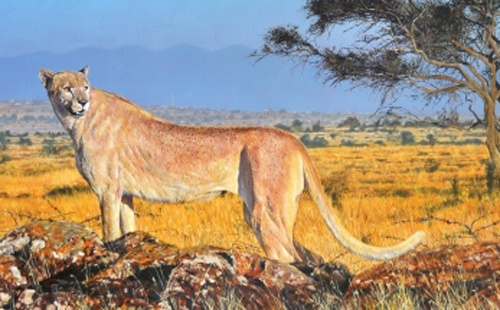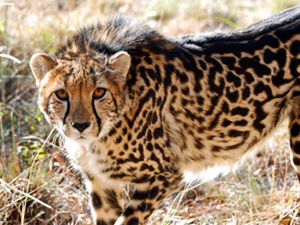
Lately there’s been a lot of research and argument about what rolls color and color patterns have in the natural selection of wild animals. The color of giraffe, the striping of zebra — it’s not just that it’s in vogue, there’s been a lot of exciting research.
Now new discussion about a spotless cheetah that was photographed nearly a year ago in Kenya is provoking some really challenging questions about natural selection.
Many animals and even more birds routinely display generations of weird coloring that is usually the result of the expression of recessive genes: the chance that both parents’ recessive genes combine in the offspring.
But studies of black squirrels in particular confounds that notion. Entire populations of grey squirrels will suddenly all be black and may remain that way for multiple generations before turning back to grey.
That has led scientists to believe that while it is true that the expression of blackness is linked to recessive genes, that perhaps those genes have a more dynamic function in natural selection than just chance.
Color in animals, particularly black and white, does have correlations to body heat control. Could it be that certain populations of animals in response to rapid climate changes somehow manage to “stack the deck” and get a recessive gene progeny that expresses itself?
It’s a fascinating question that was highlighted this week when a photograph of a spotless cheetah, taken about a year ago, suddenly began circulating around the internet.
The photograph and exciting account of the cheetah incident was made by Kenyan Guy Combes. The spotless cheetah was photographed near Tsavo National Park in Kenya.
The area in which it was found in Kenya is becoming increasingly drier. The dry areas of Namibia where cheetah have been extensively studied has determined that many of the cheetah there have fading or lost spots. Namibia is, of course, one of the driest places on earth.
All animals can have varied coloring as a result of genetic mutation, and all of the foregoing is different from albinoism, which is very rare in animals. A true albino animal will have no coloring, including in its eyes.

Black leopards, snow leopards, black cougars and jaguars are all melanistic phenomena similar to what happens to squirrels. There never seemed to be any “point” in this varied coloration. Cheetah, too, have been reported to have melanistic phases.
But cheetah have many other color variations as well. The most famous is the King Cheetah, where spots turn into swirls and brown into black. Cheetah are also known to have nearly completely white coats with black spots.
(This is not albinoism. A true albino of anything has no color whatever, including in its eyes.)
So scientists are now looking at the varied coloration of the cheetah in “new light.” If the spotless cheetah is a natural selection reaction to dry climates, then might the darker King Cheetah be in response to wetter or cooler climates?
Stay tuned!